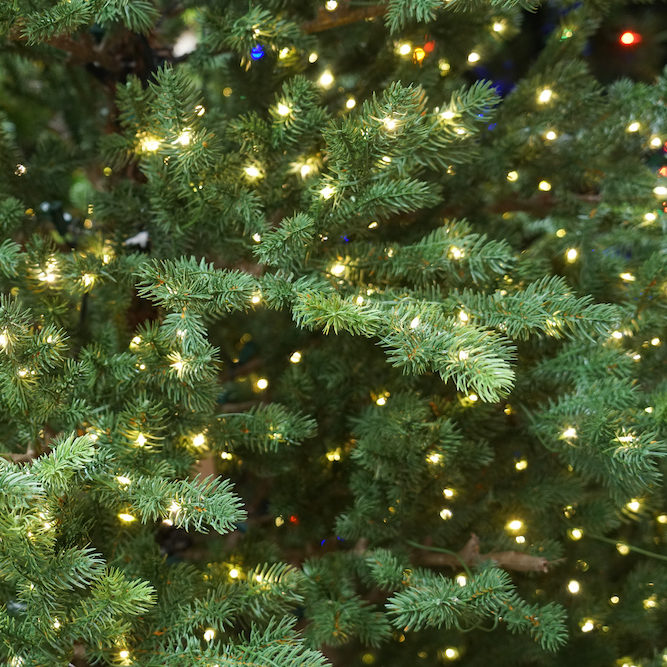
Written by Trevor Smith | Weston Nurseries Design & Education Manager
“There’s a light on this tree that won’t light on one side.”
How the Grinch Stole Christmas
Ahh, the Christmas tree.
It is the center of so many peoples’ Christmas memories. When I was growing up, we would put on “The Grinch Who Stole Christmas” on vinyl and listen to that while decorating. We had a collection of ornaments gathered through the years, and my aunt gave us new ones every year.
My mom would tell us the same stories about her special ornaments every year and my sister and I would roll our eyes. I remember coming down Christmas morning, the tree shining like a beacon of joy and love (and what seemed to my young self) to be a sea of presents. My paternal grandparents lived in a Victorian house. The center of the house was open to the third floor, with a balcony that wrapped around the second floor, leading to all the rooms. The trees were always at least 14ft tree so that we had to go to the second-floor balcony to put the star on top. Old antique ornaments and vintage lightbulbs with reflectors were some of the decorations we used on that huge tree.
Christmas is my favorite holiday and the holiday season is my favorite time of year. I love the traditions and the closeness we all feel to each other and, of course, the decorations and especially, the lights. As a professional, I have decorated and lit hundreds of trees. Bright “over the top” trees for banks and businesses, and private trees for the families who are now are a part of my holiday tradition and I, a part of theirs. I have even had the honor of decorating the 18ft Blue Room tree in the White House and even wire-framed tropical palm trees.
How to Light Your Christmas Tree
The buzz from holiday shoppers in the garden center this year has been about when we are getting the first snow and how much people hate stringing the lights but love the way they look in the falling snow. The good news is that lighting trees has become easier over the years, especially since LED’s have come to market. The “one goes out, they all go out” of Christmas lights past is not an issue anymore, and many marriages and holidays are better for it. Let me share with you two tips and techniques I have learned over the years that will deliver all the joy and sparkle while taking the uncertainty out of tree lighting.
How Many Lights:
The rule of thumb is 100 lights per vertical foot, so a 6ft tree would require 600 lights. This will give you a traditional gentle sparkling tree, which is excellent for balsam trees, small trees, and sparsely decorated trees. For a sparkling tree, 200 lights per vertical foot is the formula to use, and this is great for dense trees like Frasier firs or trees with a lot of ornaments. This is also good for porch trees or any outdoor tree. Approximately 250 to 300 is the count for trees in commercial store windows or extra-large trees. This heavy lighting is not obnoxious, but it’s a lot. If you are all about lights, then this is your range.
Hanging Lights:
The next step is hanging the lights. The two techniques I use are Triangular 1/3, 1/3,1/3, and Inside Out. For both methods, you will want to plug the lights in and apply the lights while lit. For the triangular technique, divide your tree into thirds. Starting at the top (leaving some slack in the cord), place the last bulb in the string at the top of the tree. Then, weave the strand back and forth across that 1/3 of the tree, attaching new strings of lights as needed until you reach the bottom. It is best to connect no more than 300 lights per run. Then repeat for the other 2/3 of the tree. This is a quick method easy to put on and take off.
For the Inside-Out method, start with your first strand at the bottom and work your way around the tree maypole style, beginning with the inside near the trunk. This method adds depth to the tree. Work your way to the top and then back down. Remember to keep your runs to 300 lights or 3 strands. Once the interior is lit, start your next run and work your way along the outer portion of the branches and back down. For each pass, rise the strand 6-8 inches, working your way up. This method is more time-consuming both in the application and in removal, but as mentioned, it adds depth to the tree.
Once The Lights Are Up, Next Steps:
Once your tree is lit, step back and squint your eyes. Look for any holes or dark areas and adjust accordingly, and then fill in those areas. Step back again, squint, and once you are satisfied, it’s time to decorate. When decorating, I use a similar technique to the Inside Out method and place plain balls or nondescript ornaments, both matte and shiny, on the interior. The special ornaments I place on the outer branches. I put detailed ornaments and reflective ornaments near one of the bulbs to highlight the detail or scatter the light.
Remember to keep your tree watered. I would love to see your trees; please share them on social #christmasatwestonnurseries or send me a picture of your tree or ask me a question at trevors@westonnurseries.com. Take time to enjoy the season.
Happy Holidays Everyone!








